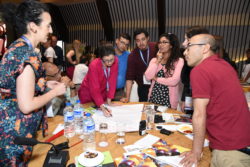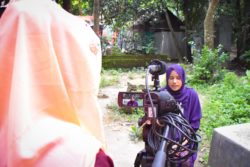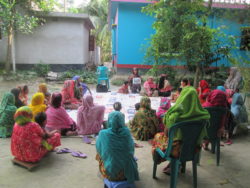Using co-produced resources out of context
At CE4AMR we champion the use of Community Engagement approaches to tackle the global challenge of AMR. Our focus on equitable partnerships and two-way knowledge exchange means that many of our research outputs are co-produced and co-owned by the community members we have worked with. For example, our participatory video projects result in short films which showcase local community knowledges on AMR and provide examples of locally appropriate behavior changes. Our community dialogues result in proposed solutions to AMR risks, that are actionable within that specific context.
Whilst these approaches have many benefits in terms of better understanding local AMR drivers, risks, and barriers to behavior change. They are also highly specific. For example, the materials within our community dialogue resources are meticulously planned to be appropriate for use within a specific community setting. Films resulting from participatory video projects reflect the current opinions and experiences of the community members who created them. This means it can be difficult to utilize such resources out of context.
drivers, risks, and barriers to behavior change. They are also highly specific. For example, the materials within our community dialogue resources are meticulously planned to be appropriate for use within a specific community setting. Films resulting from participatory video projects reflect the current opinions and experiences of the community members who created them. This means it can be difficult to utilize such resources out of context.
There are risks to sharing such specific resources in a generic way.
 For example, simply translating films into other languages and sharing them as awareness raising tools could misguide other communities to focus on AMR drivers which are not as common in their own lives. Furthermore, films produced by local community members (that are designed to reflect current experiences) risk perpetuating sometimes harmful narratives. For example, a film may showcase patriarchal power dynamics within a community. While the messages in the films may accurately reflect the current circumstances of the participant community, we should be very careful to recognize these problematic messages when sharing videos.
For example, simply translating films into other languages and sharing them as awareness raising tools could misguide other communities to focus on AMR drivers which are not as common in their own lives. Furthermore, films produced by local community members (that are designed to reflect current experiences) risk perpetuating sometimes harmful narratives. For example, a film may showcase patriarchal power dynamics within a community. While the messages in the films may accurately reflect the current circumstances of the participant community, we should be very careful to recognize these problematic messages when sharing videos.
The Community Dialogue material needs adapting by language, but the images will also need updating based on the new community and context it is to be utilized in. Without such detailed modifications the tools become redundant because they do not allow community members to connect to the challenge of AMR in their own lives meaning they cannot equitably participate in the research process.
updating based on the new community and context it is to be utilized in. Without such detailed modifications the tools become redundant because they do not allow community members to connect to the challenge of AMR in their own lives meaning they cannot equitably participate in the research process.
That is not to say that community co-produced outputs cannot be shared on a wider scale we just need to be careful how we do this.
For example, our 2018-19 participatory video project known as CARAN resulted in 6 short films considering local AMR challenges in two Nepali communities. These films were showcased to ward leaders and local government officials to demonstrate the AMR challenges faced by local people in attempt to change policy. However, the films were also used in a separate intervention, a school-based project to co-develop educational materials on AMR. Here the films were used in an orientation session to introduce teachers to the concept of AMR before they joined the project as co-developers of the education programme itself. After a short introductory lecture, the teachers watched some of the films and discussed what behaviors could be driving AMR and what solutions could be proposed.
We refer to this usage of the films as a “trigger for dialogue”
For a worked example of a session using this approach see Pages 30-31 in our AMR Education Resource Pack.  In such scenarios the films themselves are not educational or awareness raising materials but prompts for the community to reflect upon their own knowledges and experiences around a novel topic. Experienced local facilitators are required to support such a ‘trigger’ as the community need to feel comfortable questioning or contradicting the material they see in the film. However, it can be very effective in terms of allowing people to connect with an unfamiliar topic.
In such scenarios the films themselves are not educational or awareness raising materials but prompts for the community to reflect upon their own knowledges and experiences around a novel topic. Experienced local facilitators are required to support such a ‘trigger’ as the community need to feel comfortable questioning or contradicting the material they see in the film. However, it can be very effective in terms of allowing people to connect with an unfamiliar topic.
Having examples of AMR that are co-produced by communities rather than researchers allows the topic to appear more approachable, even if the resources are not from your own community. This means that it is possible to use co-produced materials out of context but with the caveat that the resources may not serve the same function for which they were designed.
Our suggested approach to using Community-produced materials out of context
The below framework can be used to develop a session using community produced outputs as ‘triggers for discussion’
- What is the aim of this session?
- What are the key messages you wish to discuss?
- Who will be attending this session?
- What resource are you using as a trigger?
- How will you introduce the resource?
- How will your audience explore the resources?
- What prompt questions will you use?
- How will you close/summarize the session?
Facilitators should carefully consider the prompts and questions for community members. Questions should be open, offering chance to critique and dissect messages within materials.
Some examples include:
What is being discussed in the resources?
- What does this mean?
- Do you recognize this challenge?
- Do you have questions?
Do you think the behaviors/actions/issues in the resource are like our own community?
- How and why?
- Do the behaviors/actions/issues differ for different community members (women, children, disabled etc.)
Do you agree with the messages in this resource?
- Why/why not?
Do you think the suggestions in the resource are actionable in this setting?
- Why/Why not
- What might be a barrier to change here that is not mentioned in the resource?
In the resource, a key message is (XXX), what key messages could you focus on in your own community?
Written by Nichola Jones and Jessica Mitchell, University of Leeds UK.
